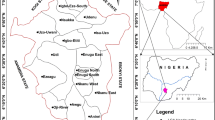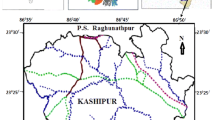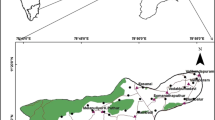Abstract
Present study tries to identify the groundwater potential areas in a plateau fringe region of the tropical environment. Groundwater is an essential natural resource of any region and it also bears the hydrogemomorphological conditions of that region. The availability of groundwater indicates the geomorphological, hydrological, pedological as well as vegetal characteristics of a particular area. The current study evaluates the status of groundwater of Bankura district, West Bengal which located in the eastern slope of Precambrian Chota Nagpur plateau dominated by granite gneiss and Gondwana deposits. Major groundwater potential zones are confined within residual weathered rocks of the district. The present study, therefore, was undertaken to identify the significant groundwater development with the help of remote sensing data. The original data sets like Landsat 8 multispectral data, aster DEM data, toposheets has been used to evaluates the hydrological, geomorphological, pedological and landuse landcover characteristics of Bankura district. Ten features (geology, geomorphology, pedology, soil texture, lineament density, relief, slope, drainage, aridity and landuse landcover) which delineates the groundwater potentiality have been analysed and integrated. The weighted raster has been created after assigning the relative weight derived from Multi-Influencing Factor (MIF) analysis. All the features have been integrated into a GIS environment. The weighted index overlay method has been followed after assigning the certain weight derived from MIF to each class of each feature. The result indicates the poor to a fairly good condition of groundwater potentiality in all over the district. The whole district has been categorized into four distinct groundwater potential zones. Very poor groundwater potential zone constitutes 6% of the total district area, covered by unweathered granite gneiss geological formations mostly. This is the area of plateau proper also. Poor groundwater potential zones occupy 39% of the total area covering proper plateau fringe region. This is the area of crystalline gneiss rock of dissected plateau. High slope and undulating characteristics of the terrain helps less infiltration of rainwater. The reasonably good condition of groundwater potentiality occupies a majority of the block, covering 46% of the total area of the district. This is the area of significant rivers interfluvial area covered by upper alluvium geological formations. Less relief and slope with high drainage density helps in easy groundwater recharging creates good groundwater potential zone. The very good potentiality of groundwater covers floodplains of major river basins in the districts occupy 9% of the whole area. This is the area of newly deposited alluvial soil helps easy recharging of groundwater.
Access this chapter
Tax calculation will be finalised at checkout
Purchases are for personal use only
Similar content being viewed by others
References
Acharya, T., Kumbhakar, S., Prasad, R., Mondal, S., & Biswas, A. (2019). Delineation of potential groundwater recharge zones in the coastal area of north-eastern India using geoinformatics. Sustainable Water Resources Management, 5(2), 533–540.
Adhikary, P. P., & Dash, Ch J. (2017). Comparison of deterministic and stochastic methods to predict spatial variation of groundwater depth. Applied Water Science, 7(1), 339–348.
Arkoprovo, B., Adarsa, J., & Animesh, M. (2013). Application of remote sensing, GIS and MIF technique for Elucidation of groundwater potential zones from a part of Orissa coastal tract, Eastern India. Research Journal of Recent Science, 2(11), 42–49.
Askari, M.S., Cui, J., O’Rourke, S.M., & Holden, N.M. (2015). Evaluation of soil structural quality using VIS–NIR spectra. Soil and Tillage Research, 146(A), 108–117.
Bready, N.C., & Well, R.R. (2005). The nature and properties of soil. Singapore: Pearson Prentice Hall.
Boschetto, R. G., Mohamed, R. M., & Arrigotti, J. (2010). Vulnerability to desertification in a sub-Saharan region: A first local assessment in five villages of southern region of Malawi. Italian Journal of Agronomy, 5(2S), 91–101.
Cosby, B. J., Hornberger, G. M., Clapp, R. B., & Ginn, T. R. (1984). A statistical exploration of the relationships of soil moisture characteristics to the physical properties of soils. Water Resources Research, 20(6), 682–690.
Das, S. (2017). Delineation of groundwater potential zone in hard rock terrain in Gangajalghati block, Bankura district, India using remote sensing and GIS techniques. Modeling Earth Systems and Environment, 3(4), 1589–1599.
Frankl, A., Poesen, J., Haile, M., Deckers, J., & Nyssen, J. (2013). Quantifying long-term changes in gully networks and volumes in dryland environments: The case of Northern Ethiopia. Geomorphology, 201, 254–263.
Ghosh, P. K., Bandyopadhyay, S., & Jana, N. C. (2016). Mapping of groundwater potential zones in hard rock terrain using geoinformatics: A case of Kumari watershed in western part of West Bengal. Modeling Earth Systems and Environment, 2(1), 1–16.
Ghosh, S., & Guchhait, S. K. (2015). Characterization and Evolution of Laterites in West Bengal: Implication on the geology of Northwest Bengal Basin. Transactions, 37(1), 93–119.
Girmay, G., Singh, B. R., Nyssen, J., & Borrosen, T. (2009). Runoff and sediment-associated nutrient losses under different land uses in Tigray, Northern Ethiopia. Journal of Hydrology, 376, 70–80.
Gupta, M., & Srivastava, P. K. (2010). Integrating GIS and remote sensing for identification of groundwater potential zones in the hilly terrain of Pavagarh, Gujarat, India. Water International, 35(2), 233–245.
Guru, B., Seshan, K., & Bera, S. (2017). Frequency ratio model for groundwater potential mapping and its sustainable management in cold desert, India. Journal of King Saud University—Science, 29(3), 333–347.
Jagannathan, K., et al. (1996). An approach to demarcate ground water potential zones through remote sensing and geographic information system remote sensing and a geographical information system. International Journal of Remote Sensing, 17(10), 1867–1884.
Jaiswal, R. K., Mukherjee, S., Krishnamurthy, J., & Saxena, R. (2010). Role of remote sensing and GIS techniques for generation of groundwater prospect zones towards rural development–an approach. International Journal of Remote Sensing, 24(5), 993–1008.
Kafle, H. K., & Bruins, H. J. (2009). Climatic trends in Israel 1970–2002: Warmer and increasing aridity inland. Climatic Change, 96, 63–77.
Lal, R. (2004). Soil carbon sequestration in India. Climatic Change, 65(3), 277–296.
Lenka, N. K., Mandal, D., & Sudhishri, S. (2014). Permissible soil loss limits for different physiographic regions of West Bengal. Research Communications, 107(4), 665–670.
Magesh, N. S., Chandrasekar, N., & Soundranayagam, J. P. (2012). Delineation of groundwater potential zones in Theni district, Tamil Nadu, using remote sensing, GIS and MIF techniques. Geoscience Frontiers, 3(2), 189–196.
Mahala, A. (2017). Processes and status of land degradation in a plateau fringe region of tropical environment. Environmental Processes, 4(3), 663–682.
Mahala, A. (2018a). Soil erosion estimation using RUSLE and GIS techniques—A study of a plateau fringe region of tropical environment. Arabian Journal of Geosciences, 11(13), 1–18.
Mahala, A. (2018). Identifying the factors and status of land degradation in a tropical plateau region. Geojournal, 84(5), 1199–1218.
Mahala, A., & Pani, P. (2018). Land degradation in Eastern Chotanagpur plateau: A study of the Silabati River Basin. NAGI, 38(1), 27-42.
Mondal, S. (2012). Remote sensing and GIS based ground water potential mapping of Kangshabati irrigation command area, West Bengal. Geography & Natural Disasters, 1(1), 1–8.
Nag, S. K., & Ghosh, P. (2013). Delineation of groundwater potential zone in Chhatna Block, Bankura District, West Bengal, India using remote sensing and GIS techniques. Environmental Earth Sciences, 70(5), 2115–2127.
Nag, S. K., & Kundu, A. (2018). Application of remote sensing, GIS and MCA techniques for delineating groundwater prospect zones in Kashipur block, Purulia district, West Bengal. Applied Water Science, 8(1), 1–13.
Nyssen, J., Poesen, J., Haregeweyn, N., & Parsons, T. (2008). Environmental change, geomorphic processes and land degradation in tropical highlands. Catena, 75(1), 1–4.
Pande, C. B., Khadri, S. F. R., Moharir, K. N., & Patode, R. S. (2018). Assessment of groundwater potential zonation of Mahesh River basin Akola and Buldhana districts, Maharashtra, India using remote sensing and GIS techniques. Sustainable Water Resources Management, 4(4), 965–979.
Peiffer, S. (2007). Groundwater management and development by integrated remote sensing and geographic information systems: Prospects and constraints. Water Resources Management, 21, 427–467.
Rashid, M., Lone, M.A., & Romshoo, S.A. (2011). Geospatial tools for assessing land degradation in Budgam district, Kashmir Himalaya, India. Journal of Earth System Science, 120, 423–433 (June).
Sarkar, D., Mandal, D., & Halder, A. (2014). Soil maturity assessment along a toposequence in Chotanagpur Plateau, West Bengal using inorganic soil phosphorus based weathering index, soil taxonomy and other chemical indices: A comparative study. Agropedology, 24(1), 82–94.
Sar, N., Khan, A., Chatterjee, S., & Das, A. (2015). Hydrologic delineation of ground water potential zones using geospatial technique for Keleghai river basin, India. Modeling Earth Systems and Environment, 1(3), 1–15.
Saraf, A. K., & Choudhury, P. R. (2010). Integrated remote sensing and GIS for groundwater exploration and identification of artificial recharge sites. Journal of Remote Sensing, 19(10), 1825–1841.
Senanayake, I. P., Dissanayake, D. M. D. O. K., Mayadunna, B. B., & Weerasekera, W. L. (2016). An approach to delineate groundwater recharge potential sites in Ambalantota, Sri Lanka using GIS techniques. Geoscience Frontiers, 7(1), 115–124.
Sener, E., Davraz, A., & Ozcelik, M. (2005). An integration of GIS and remote sensing in groundwater investigations: A case study in Burdur, Turkey. Hydrology Journal, 13, 826–834.
Shaban, A., Khawlie, M., & Abdallah, C. (2006). Use of remote sensing and GIS to determine recharge potential zones: The case of Occidental Lebanon. Hydrogeology Journal, 14(4), 433–443.
Shit, P. K., & Maity, R. (2012a). Rill Hydraulics—An experimental study on Gully Basin in Lateritic Upland of Paschim Medinipur, West Bengal, India. Journal of Geography and Geology, 4(4), 1–11.
Shit, P. K., & Maity, R. K. (2012b). Mechanism of Gully-Head Retreat—A study at Ganganir Danga, Paschim Medinipore, West Bengal. Ethiopian Journal of Environmental Studies and Management, 5(4), 332–342.
Taye, G., et al. (2013). Effects of land use, slope gradient, and soil and water conservation structures on runoff and soil loss in semi-arid Northern Ethiopia. Physical Geography, 34(3), 236–259.
Thapa, R., Gupta, S., Guin, S., & Kaur, H. (2017). Assessment of groundwater potential zones using multi-influencing factor (MIF) and GIS: A case study from Birbhum district, West Bengal. Applied Water Science, 7(7), 4117–4131.
Yeh, H. F., Cheng, Y. S., Lin, H. I., & Lee, C. H. (2016). Mapping groundwater recharge potential zone using a GIS approach in Hualian River, Taiwan. Sustainable Environment Research, 26(1), 33–43.
Zaffar, M., & Sheng-Gao, L. (2015). Pore size distribution of clayey soils and its correlation with soil organic matter. Pedosphere, 25(2), 240–249.
Acknowledgements
The work has been conducted with the financial support of the University Grants Commission (UGC). The authors like to thank National Bureau of Soil Science (NBSS) for providing Soil data. The author is deeply thankful to his supervisor Dr Padmini Pani, Associate Professor, CSRD for her suggestions.
Author information
Authors and Affiliations
Corresponding author
Editor information
Editors and Affiliations
Rights and permissions
Copyright information
© 2021 Springer Nature Switzerland AG
About this chapter
Cite this chapter
Mahala, A. (2021). Delineating the Status of Groundwater in a Plateau Fringe Region Using Multi-influencing Factor (MIF) and GIS: A Study of Bankura District, West Bengal, India. In: Adhikary, P.P., Shit, P.K., Santra, P., Bhunia, G.S., Tiwari, A.K., Chaudhary, B.S. (eds) Geostatistics and Geospatial Technologies for Groundwater Resources in India. Springer Hydrogeology. Springer, Cham. https://doi.org/10.1007/978-3-030-62397-5_11
Download citation
DOI: https://doi.org/10.1007/978-3-030-62397-5_11
Published:
Publisher Name: Springer, Cham
Print ISBN: 978-3-030-62396-8
Online ISBN: 978-3-030-62397-5
eBook Packages: Earth and Environmental ScienceEarth and Environmental Science (R0)




